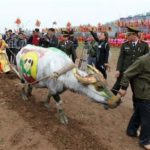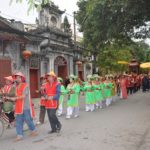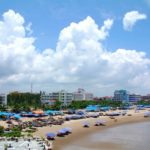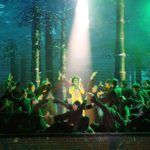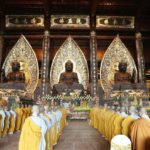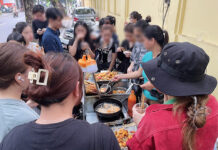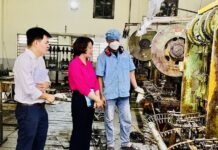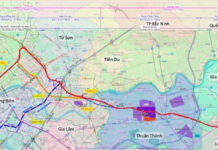The exhibition showcases photos of Hanoi taken by renowned photographer Jean-Paul Goude, between 1978 and 1980. The images capture the city’s unique charm, its people, and its customs, as well as the development of the city in the last four decades. Through this exhibition, visitors can observe the transformation of Hanoi from an ancient city into a modern, western-style city.
The photo exhibition, themed “Hanoi – The Beginning of a Western City in Southeast Asia”, is part of the 12th Vietnam-France Cooperation Conference organized by Hanoi and the Ile-de-France Region. Capturing the unique charm of Hanoi, renowned photographer Jean-Paul Goude has showcased photos taken between 1978 and 1980. The exhibition offers viewers an insight into the city’s people, customs, and development over the past four decades. It also provides an opportunity to observe the transformation of Hanoi from an ancient city into a modern, western-style city.
| The space of the photo exhibition. Photo: Nam Nguyen |
Being on display until April 22, the exhibition features 30 vibrant color photographs taken by Léon Busy between 1915 and 1921, considered the first vivid color photographs of Hanoi. These photographs offer a unique and captivating glimpse into the city’s history, providing an insight into life in the city during the colonial era.
These photographs illustrate the evolution of Hanoi’s urban landscape. From public works that have been a staple of the city for centuries, to the emergence of Western influence in the living spaces of the Old Quarter, these images demonstrate the remarkable transformation of Hanoi over time. Details such as clothing, signage, and other indicators of modernization stand out in the frames, highlighting the city’s progress.
Highlights of the photo exhibitions include a stunning photo taken inside Quan Thanh Temple showcasing a magnificent crystal chandelier imported directly from France; a captivating image of enchanting Vietnamese girls with macaron hairstyles and grand buckled shoes – an iconic motif in French fashion magazines during the 1910s; and riveting photos of press posters in French depicting the enthusiasm of the French press in Vietnam during the early twentieth century.
According to Duong Duc Tuan, Deputy Chairman of the Hanoi People’s Committee, cooperation between Hanoi and the Ile-de-France region of France dates back to 1989 when the two signed a decentralized cooperation agreement – the first of its kind between Vietnam and France as well as one of the oldest international partnerships of the Ile-de-France region.
| “Hanoi – The Beginning of a Western City in Southeast Asia” featured 30 color photographs taken by Léon Busy. Participants in the exhibition. Photo: Nam Nguyen |
“The two localities have worked together collaboratively and effectively over the past year to promote sustainable development, urban planning, culture, and heritage conservation,” he said.
“In the coming period, the City of Hanoi and the Ile-de-France region will continue to amass, display, and feature documents concerning the genesis of the Old Quarter and the cultural influences and exchanges between France and Vietnam during the first half of the twentieth century,” he added.
Located in the heart of the old quarter of Hanoi, the villa is a unique example of French colonial architecture in Vietnam. It is a combination of the traditional Vietnamese style and the French architectural art.
Villa 49 Tran Hung Dao is an iconic example of French colonial architecture in Vietnam, perfectly combining traditional Vietnamese and French aesthetics. Located in the heart of the old quarter of Hanoi, the villa was the first to be restored and embellished by the city, with technical support provided by the Ile-de-France Region. It stands as a beautiful testament to the two countries’ shared past and culture.
In February 2022, Hanoi and the Ile-de-France region signed a comprehensive cooperation agreement for the period of 2022-2025, with a particular emphasis on planning and urban management – areas in which the French region possesses a considerable amount of expertise. Additionally, in June 2018, both parties had signed a joint action plan for 2018-2021, with the intention of launching various new joint initiatives in the fields of innovation and research.
Furthermore, the Ile-de-France region has also provided support to Hanoi in its efforts to have the Hanoi Citadel inscribed on the UNESCO World Heritage List.
| The photos showcase the strong transformation of Hanoi in terms of culture and architect during the early 20 century. Photo: Nam Nguyen |
Tam Chuc Pagoda – Ancient beauty amidst majestic scenery
Covering 5,100 ha, Tam Chuc complex is a perfect combination of ancient beauty and the mighty of the immense mountain.




